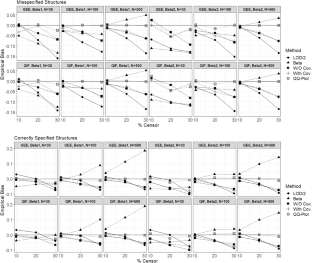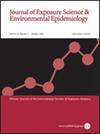Compare the marginal effects for environmental exposure and biomonitoring data with repeated measurements and values below the limit of detection
IF 4.7
3区 医学
Q2 ENVIRONMENTAL SCIENCES
Journal of Exposure Science and Environmental Epidemiology
Pub Date : 2024-01-22
DOI:10.1038/s41370-024-00640-7
引用次数: 0
Abstract
Environmental exposure and biomonitoring data with repeated measurements from environmental and occupational studies are commonly right-skewed and in the presence of limits of detection (LOD). However, existing model has not been discussed for small-sample properties and highly skewed data with non-detects and repeated measurements. Marginal modeling provides an alternative to analyzing longitudinal and cluster data, in which the parameter interpretations are with respect to marginal or population-averaged means. We outlined the theories of three marginal models, i.e., generalized estimating equations (GEE), quadratic inference functions (QIF), and generalized method of moments (GMM). With these approaches, we proposed to incorporate the fill-in methods, including single and multiple value imputation techniques, such that any measurements less than the limit of detection are assigned values. We demonstrated that the GEE method works well in terms of estimating the regression parameters in small sample sizes, while the QIF and GMM outperform in large-sample settings, as parameter estimates are consistent and have relatively smaller mean squared error. No specific fill-in method can be deemed superior as each has its own merits.


比较重复测量的环境暴露和生物监测数据的边际效应以及低于检测限值的值
背景环境和职业研究中重复测量的环境暴露和生物监测数据通常是右偏的,而且存在检出限(LOD)。方法我们概述了三种边际模型的理论,即广义估计方程(GEE)、二次推断函数(QIF)和广义矩法(GMM)。结果我们证明,GEE 方法在估计小样本量回归参数方面效果良好,而 QIF 和 GMM 在大样本设置中表现更佳,因为参数估计一致,均方误差相对较小。影响边际建模首先用于分析带有非检测项的重复测量数据,其中只需正确提供均值结构即可获得一致的参数估计。在通过替换法和小样本偏差校正法替换非检测项目后,我们在模拟研究中发现,边际模型中使用的估计方法在各种样本量下都具有相应的优势。我们还将模型应用于纵向和群组工作实例。
本文章由计算机程序翻译,如有差异,请以英文原文为准。
求助全文
约1分钟内获得全文
求助全文
来源期刊
CiteScore
8.90
自引率
6.70%
发文量
93
审稿时长
3 months
期刊介绍:
Journal of Exposure Science and Environmental Epidemiology (JESEE) aims to be the premier and authoritative source of information on advances in exposure science for professionals in a wide range of environmental and public health disciplines.
JESEE publishes original peer-reviewed research presenting significant advances in exposure science and exposure analysis, including development and application of the latest technologies for measuring exposures, and innovative computational approaches for translating novel data streams to characterize and predict exposures. The types of papers published in the research section of JESEE are original research articles, translation studies, and correspondence. Reported results should further understanding of the relationship between environmental exposure and human health, describe evaluated novel exposure science tools, or demonstrate potential of exposure science to enable decisions and actions that promote and protect human health.

 求助内容:
求助内容: 应助结果提醒方式:
应助结果提醒方式:


